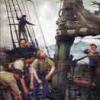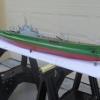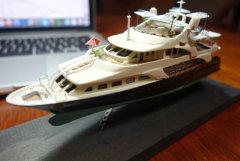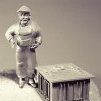MORE HANDBOOKS ARE ON THEIR WAY! We will let you know when they get here.
×
-
Posts
366 -
Joined
-
Last visited
Reputation Activity
-
 steamschooner got a reaction from mtaylor in Building Small Scale Ships Boats by Jim Lad - Part 1
steamschooner got a reaction from mtaylor in Building Small Scale Ships Boats by Jim Lad - Part 1
Sure John, Post this AFTER I just finished making my two small boats. But you can bet that I will follow you along on this.
-
 steamschooner got a reaction from Jim Lad in Building Small Scale Ships Boats by Jim Lad - Part 1
steamschooner got a reaction from Jim Lad in Building Small Scale Ships Boats by Jim Lad - Part 1
Sure John, Post this AFTER I just finished making my two small boats. But you can bet that I will follow you along on this.
-
 steamschooner reacted to ggrieco in Heroine 1838 by ggrieco - FINISHED - Scale 1:24 - Western River Steamboat as she appeared before hitting a snag in the Red River
steamschooner reacted to ggrieco in Heroine 1838 by ggrieco - FINISHED - Scale 1:24 - Western River Steamboat as she appeared before hitting a snag in the Red River
I've been busy laying out the internal structure on the boiler deck so I haven't had the opportunity to get many photos. Just a few here to show progress.
The internal walls would have been planked and then the bulkheads added. I'm putting the bulkheads in first and will then plank between them. This will allow me to economize on wood by using shorter pieces. It's amazing how much planking this model requires and I'm running out of the long lengths.
The arches over the paddle box are just about complete. I still need to add the steps up over the arch and the exposed planking will be painted white on the starboard side.
-
 steamschooner got a reaction from Canute in Building Small Scale Ships Boats by Jim Lad - Part 1
steamschooner got a reaction from Canute in Building Small Scale Ships Boats by Jim Lad - Part 1
Sure John, Post this AFTER I just finished making my two small boats. But you can bet that I will follow you along on this.
-
 steamschooner got a reaction from Seventynet in Building Small Scale Ships Boats by Jim Lad - Part 1
steamschooner got a reaction from Seventynet in Building Small Scale Ships Boats by Jim Lad - Part 1
Sure John, Post this AFTER I just finished making my two small boats. But you can bet that I will follow you along on this.
-
 steamschooner reacted to Jim Lad in Building Small Scale Ships Boats by Jim Lad - Part 2
steamschooner reacted to Jim Lad in Building Small Scale Ships Boats by Jim Lad - Part 2
For planking these boats I use my favourite Privet, as the planks are under 0.5MM in thickness and have to cope with a fair amount of bending. I know that Privet isn’t available commercially; however any hard, very close grained timber that can take the bending will work.
I usually plank boats like this with the planks a little over scale width. What we want is a good look for the boats as much as strict scale, so the over-width planks work well in this context. The width of each plank is easily decided by measuring around the girth of the proposed boat and dividing by the number of planks you want. In the case of these boats, I opted for a wider sheer strake so that I could fit a rubbing strake, as you’ll see later.
Each plank will need to be shaped to fit and also chamfered along its lower edge and at the ends, if the planks are to fill well.
The garboard strake is obviously the first one to fit. Being the first plank on, it won’t need chamfering along its length, but will need the chamfering at the ends. The chamfering of the ends of the planks helps them to fit neatly into the rebate of the stem and stern post and also helps them to bend into the adjoining planks at the ends. Be careful in cutting the planks to length as they need to be a really good fit in the bow and stern rebates.
The garboard strake can be made from a straight piece of timber, but it will need some pretty extreme bending at both ends, as can be seen in the photos. I find that the garboard is usually the only strake that needs to be steamed or boiled to allow the extreme bend to be put into it.
Also, before fitting each plank, draw an overlap line along it. You can’t see inside the boat to judge the amount of overlap on the planks, so a line drawn on the previous plank will help to position them correctly.
Once the plank is bent to shape, put a dab of glue on each frame plus along the edge of the plank and at the extreme ends and hold it carefully in place until the glue sets. I find it helpful to glue only half of each plank on at a time. It takes longer, but it helps to position the planks accurately.
Work back and forth on each side of the boat planking both sides evenly. After the garboard strake, each strake will probably need to be cut to a curve to fit easily – you don’t want to force the planks into position. On the boats for the Herzogin Cecilie, I found that the planks needs a curve cut into them of from one to three MM as the planking progressively went up the hull. In the case of these boats, there was no ‘reverse curve’ in the planks at the turn of the bilge, which can usually be expected in clinker boats.
Remember to chamfer off the bottom edge of each plank to give a good tight fit against the preceding plank and, naturally, don’t rush – a clinker boat will only look right if the planking is even along the length of the boat on both sides.
Don’t worry too much about excess glue getting on the planks – they can easily be cleaned up later with a fine file, so long as you’re using a good, fine grained wood. Here is one of the lifeboats with the planking completed, but showing it ‘warts and all’ before clean-up.
And this is what it looks like after just a quick, rough clean.
With the boat still on the plug (for rigidity), clean up the planks, keel, stem and stern posts and file them down to their correct thickness. Also at this time fit any outboard features such as a rubbing strake. On these boats, the rubbing strake (not present on the launch) helped to strengthen the bare hull, which is a little fragile.
Once the external work on the hull is complete, the boat can be removed from the plug. Simply cut through the frames at the top of the planking; cut through the stem and stern posts just above where their final height above the gunwale will be and then down between the posts and the plug (to free the glue) and the boat should simply pop off its plug.
Here is a work boat with the planking completed and ready to come off the plug, with the second one just freed from the plug. You can see the film still in the boat that’s just been freed. This film will just pull out of the boat, except for any spots where glue has leaked through, in which case a clean-up with a sharp blade will soon fix it.
Once the boat is off the plug, the internal finish will vary greatly depending on the type of boat. These boats were fitted with floor boards and thwarts together with side benches for the lifeboats. Remember to paint as you go, as some internal parts will be impossible to reach once they’re fitted out. In the case of these boats, I painted the inside of the hull before the floorboards were fitted so that they would be white beneath the flooring.
Another trick (not photographed) is to make the thwarts slightly thicker than scale and then chamfer any visible edges to make them appear to be scale thickness. This will give a little more strength to the thwarts, which need to be solid enough to keep the sides of the boat in shape, as double ended boats tend to try and collapse towards the centreline.
Another point to make life a little easier is to fit way oversize pieces as the gunwale capping, not worrying about anything but having them cover the top of the gunwale and frames and fit together neatly. Once thy have been glued down they can easily be trimmed back to their correct size – much easier than trying to cut and fit small curved pieces of the correct width in the first place.
Finally, with the other three boats having been delivered, here are the launch and the work boats complete and ready for delivery to the model of the barque. I had held back the launch as we’re showing the barque as she was when she was just departing from Port Lincoln, South Australia, on her last voyage in 1936 and the launch will be depicted as having just been stowed on the forward skids and still with the little outboard motor attached.
By the way – a note on the grab lines around the lifeboats and work boats. This scale is really too small to show the tiny ringbolts used on the full sized boats for becketing these lines, so what I do is to drill a series of small holes along the side of the boat under the rubbing strake and simply glue bights of the line into them.
John
-
 steamschooner reacted to Jim Lad in Building Small Scale Ships Boats by Jim Lad - Part 1
steamschooner reacted to Jim Lad in Building Small Scale Ships Boats by Jim Lad - Part 1
Some time ago I advised that I needed to stop work on my ‘Francis Pritt’ in order to build a set of boats for a 1:96 scale model of the four masted barque ‘Herzogin Cecilie’ that a group of us were re-building for the museum. I was asked at the time whether I could let people know how I built small clinker planked ship’s boats so here, at last, is a bit of a description on how I go about it. Just to whet your appetite, here are all six boats in various stages of completion. The piece of wood across the inside of the boat at bottom right is to stop it from trying to close up before the thwarts are fitted.
The first thing is to make a plug to the dimensions of the inside of the boat’s hull, but considerably taller than the boat. The reason for this will become apparent shortly. Any sort of wood will do for this, but a soft wood is easier for carving.
You can see from the photo that these plugs have been used before. The rough line of the gunwale has been marked on the plug plus a guide for positioning the frames.
Now you need to cut some fine pieces of wood for the frames. Again, the choice is yours, but I’ve found that for most boats at 1:96 some of the very fine scale wood used by model railway enthusiasts works well and is fairly easy to come by in a range of small sizes. In this case the wood came from America and is, I think, birch. Cut sufficient lengths for all the frames plus a few spares, ensuring that each frame in long enough to bend around the plug to a position well above the gunwale of the boat.
Steam or boil the frames until they are soft and pliable. I have an old saucepan I use to boil my timber on the kitchen stove. This method works well, especially if you are softening a lot of pieces at the same time. Once pliable, bed the frames over the plug and hold them in place with elastic bands. The frames don’t have to be in their correct positions at this stage – just roughly arranged along the plug so that they come reasonably close to their final shape. I find that it’s a good idea to use at least to rubber bands for the job; otherwise as you put the end of a frame under the band the one next to it is liable to pop out. If you use two bands they can hold alternate frames and make the job easier.
In this case I added an extra rubber band when I’d finished all the bending just to make sure the frames were held tightly against the plug. Don’t worry too much if some of the frames crack as you’re bending them – that’s why you cut extra.
Now for one of the ‘tricks of the trade’. We’re going to use quite a bit of glue in making these boats and if any of it happens to seep down between the frames and the plug it will be impossible to remove the completed hull from the plug, so – some people wax plugs to stop glue sticking, but a surer way is to use a bit of Glad Wrap; cling wrap; kitchen film; whatever it’s called where you live, but I mean the clingy plastic film used in the kitchen for covering such things as plates of sandwiches or cakes.
Cut a small piece of this film slightly longer than the boat and just wide enough to go over the plug down to the line of the gunwale. With the film between the plug and the frames, there’s no way the hull can stick onto the plug!
Now we can starting fitting the frames. Place the midships frame over the plug; ensure that it’s square and sitting down hard on the plug and glue the top ends of the frame to the plug above the line of the gunwale, at the same time ensuring that your piece of plastic film hasn’t slipped out of place.
You’ll need to clamp the frames in place while the glue sets to ensure that it’s sitting tight against the plug. As I use fast setting epoxy for this sort of work I simply hold each frame in place with my fingers while the glue sets, but if you use CA, you’ll need to devise another method of clamping. Keep working fore and aft with the frames until they are all firmly glued in place. I find that I can hold several frames in place at once while the glue dries. As you reach the bow and stern, fold the extra length of film around the end of the plug and hold the folds in place with the final frames. This will ensure that no glue can leak under the film at the ends.
Once all the frames are in place, cut a piece of wood of suitable thickness for the keel, but cut it deeper and longer than needed. Carefully glue the keel piece in place to the frames along the midships line fore and aft.
I find that there’s no need to rebate the keel, as the garboard strake will be fixed to it with a good line of glue; however the bow and stern posts will need to be rebated to provide a landing for the plank ends. These rebates should be in a little from the inboard edge of the posts. Again, cut the bow and stern posts wider than required and make them long enough to reach from the feel to the top of the plug. A small groove is cut in these from the keel end up to the height of the gunwale and both posts are then glued to the keel and the top of the plug, ensuring that they are hard up against the plug.
In the first of the following photos you can see the pencil marks where I have marked the stem post for the height of the gunwale and the top of the plug.
When the ‘backbone’ of the boat is in place and the glue nicely hardened, planking can commence.
.
This topic will be concluded in Part 2.
John
-
 steamschooner reacted to Omega1234 in Majellan by Omega1234 - FINISHED - 1/200 - Luxury 37 m Motor Yacht - Miniature
steamschooner reacted to Omega1234 in Majellan by Omega1234 - FINISHED - 1/200 - Luxury 37 m Motor Yacht - Miniature
Hi everyone and thanks for all of your comments and Likes!
Well....look what Majellan's naughty rich guests have done. They've dragged their chairs up to the tiny piece of deck in front of the Bridge's windows. What's more, one cheeky guest has even brought up her own umbrella to shade from the sun! And all of this in full view of the Captain!
Outrageous, I say!
Anyhow, in reality, I've added the umbrella, a table and an assortment of chairs to bring some 'life' to this part of the bridge deck. To further add atmosphere, the chairs are haphazardly pointing in different directions, as if to give the impression that the guests have just left in a hurry.
I hope you enjoy the photos.
Cheers
Patrick
-
 steamschooner reacted to RGL in HMS Dreadnought 1907 by RGL - FINISHED - Zvezda - 1/350- PLASTIC
steamschooner reacted to RGL in HMS Dreadnought 1907 by RGL - FINISHED - Zvezda - 1/350- PLASTIC
The trickiest thing so far, the davits, with the canvas straps replaced, rigging attached and the smaller whalers.
-
 steamschooner reacted to RGL in HMS Dreadnought 1907 by RGL - FINISHED - Zvezda - 1/350- PLASTIC
steamschooner reacted to RGL in HMS Dreadnought 1907 by RGL - FINISHED - Zvezda - 1/350- PLASTIC
The large boats now added to the ship.
And the breakwaters.
-
 steamschooner got a reaction from mtaylor in Top sail schooner by Piet - FINISHED - 1:2000 - BOTTLE - shipyard diorama
steamschooner got a reaction from mtaylor in Top sail schooner by Piet - FINISHED - 1:2000 - BOTTLE - shipyard diorama
Piet, wonderful build in a bulb and it does look like you had fun building it!
-
 steamschooner got a reaction from tarbrush in John Cudahy by steamschooner - FINISHED - 1/4" scale - Steam Tug
steamschooner got a reaction from tarbrush in John Cudahy by steamschooner - FINISHED - 1/4" scale - Steam Tug
Since I now have boats built for my project, it follows that I will need boat davits. The only info I have on these is what I can pick out in the photos I have. These are some shots of what I came up with. I still need to add cleats, limit strap and a collar for locking in place. I have temporary pins in pivot points at this time. Every thing will get cleaned up and blackened.
-
 steamschooner got a reaction from tarbrush in John Cudahy by steamschooner - FINISHED - 1/4" scale - Steam Tug
steamschooner got a reaction from tarbrush in John Cudahy by steamschooner - FINISHED - 1/4" scale - Steam Tug
While I work on my boats for my project I have just received a new toy/tool. Its a rolling mill and here is a example of that I can use it for. These mast bands which are for my current project were made from rolled copper wire I just need to blacken them.
-
 steamschooner got a reaction from mmdd in John Cudahy by steamschooner - FINISHED - 1/4" scale - Steam Tug
steamschooner got a reaction from mmdd in John Cudahy by steamschooner - FINISHED - 1/4" scale - Steam Tug
Since I now have boats built for my project, it follows that I will need boat davits. The only info I have on these is what I can pick out in the photos I have. These are some shots of what I came up with. I still need to add cleats, limit strap and a collar for locking in place. I have temporary pins in pivot points at this time. Every thing will get cleaned up and blackened.
-
 steamschooner got a reaction from Piet in Top sail schooner by Piet - FINISHED - 1:2000 - BOTTLE - shipyard diorama
steamschooner got a reaction from Piet in Top sail schooner by Piet - FINISHED - 1:2000 - BOTTLE - shipyard diorama
Piet, wonderful build in a bulb and it does look like you had fun building it!
-
 steamschooner reacted to Cathead in USRC Ranger 1819 by Cathead – FINISHED – Corel – Scale 1:64
steamschooner reacted to Cathead in USRC Ranger 1819 by Cathead – FINISHED – Corel – Scale 1:64
Stage 5: planking the deck and bulwarks
I'm not terribly impressed with the wood quality supplied for the decking. It's cut very roughly along the edges, necessitating a fair amount of sanding to get a smooth edge sometimes, which then makes it harder to arrange tight joints between deck planks.
I began by drawing a square grid on the plywood deck, to help guide my planking. The plans show a fairly short plank length, which looked too busy to me and contradicted what I'd read elsewhere about planking normally running 20'-24' in this period. So I cut my planks to about 20' instead. I started at the stern along the centerline, and worked my way forward and out. You can see my grid in the second photo. Wherever I overlapped a hole (for masts or other purposes), I stopped when one plank crossed it, filed out that side of the hole, then kept going, filing the remainder when the next plank went in. This way I didn't have to drill anything and risk cracking the wood.
Here's the finished deck before sanding. I think it came out nicely. Now I'm considering whether, and how, to simulate treenails (or the bolt and plug equivalent). The photo below shows one test, using thin holes filled with pencil, the seams gently lined with pencil, and the whole thing sanded and oiled. I'm trying to decide if it looks good, or out of scale and too busy.
While researching treenail approaches, I ran across one mildly embarrassing thing. I'd followed the plans' approach to plank pattern, just alternating butt ends back and forth. Seems that a more prototypical way is a four-stage staggered layout, which is eminently sensible from an engineering point of view, but like a fool I just followed the plans again. So the deck may not be right to an expert, but at least it's visually pleasing (to me, anyway).
Once I decide, I'll finish the deck, then construct the bulwarks. Only then do I go back to planking the second layer on the hull.
Anyone have thoughts on the test approach to treenails?
-
 steamschooner got a reaction from Pieman in John Cudahy by steamschooner - FINISHED - 1/4" scale - Steam Tug
steamschooner got a reaction from Pieman in John Cudahy by steamschooner - FINISHED - 1/4" scale - Steam Tug
Since I now have boats built for my project, it follows that I will need boat davits. The only info I have on these is what I can pick out in the photos I have. These are some shots of what I came up with. I still need to add cleats, limit strap and a collar for locking in place. I have temporary pins in pivot points at this time. Every thing will get cleaned up and blackened.
-
 steamschooner got a reaction from IgorSky in Top sail schooner by Piet - FINISHED - 1:2000 - BOTTLE - shipyard diorama
steamschooner got a reaction from IgorSky in Top sail schooner by Piet - FINISHED - 1:2000 - BOTTLE - shipyard diorama
Piet, wonderful build in a bulb and it does look like you had fun building it!
-
 steamschooner got a reaction from Canute in Top sail schooner by Piet - FINISHED - 1:2000 - BOTTLE - shipyard diorama
steamschooner got a reaction from Canute in Top sail schooner by Piet - FINISHED - 1:2000 - BOTTLE - shipyard diorama
Piet, wonderful build in a bulb and it does look like you had fun building it!
-
 steamschooner got a reaction from hexnut in John Cudahy by steamschooner - FINISHED - 1/4" scale - Steam Tug
steamschooner got a reaction from hexnut in John Cudahy by steamschooner - FINISHED - 1/4" scale - Steam Tug
Since I now have boats built for my project, it follows that I will need boat davits. The only info I have on these is what I can pick out in the photos I have. These are some shots of what I came up with. I still need to add cleats, limit strap and a collar for locking in place. I have temporary pins in pivot points at this time. Every thing will get cleaned up and blackened.
-
 steamschooner got a reaction from Omega1234 in Top sail schooner by Piet - FINISHED - 1:2000 - BOTTLE - shipyard diorama
steamschooner got a reaction from Omega1234 in Top sail schooner by Piet - FINISHED - 1:2000 - BOTTLE - shipyard diorama
Piet, wonderful build in a bulb and it does look like you had fun building it!
-
 steamschooner reacted to Piet in Top sail schooner by Piet - FINISHED - 1:2000 - BOTTLE - shipyard diorama
steamschooner reacted to Piet in Top sail schooner by Piet - FINISHED - 1:2000 - BOTTLE - shipyard diorama
Hello everyone and best wishes. Thank you Mark, Igor, Carl, Julie Mo and Patrick for your very kind words and of course a heartfelt thanks to all who clicked the like button.
This will most likely be the last post of my effort to make a micro mini diorama. It's not a Dutch shipyard as Amateur Jan would have liked but I opted for something we could expect somewhere in New England.
Is it perfect? No, not by a long shot but the main thing is that I learned a lot and had a lot of fun doing it. There is still that Dutch jacht or fishing boat in a lamp awaiting to do - - - - someday.
Thank you all for visiting and your helpful hints and encouragement along the way. My next "little" project will be started in the kit building section but I'll also continue with my VOC ship Surabaya. Gwen would like to see it finished so I can start with her father's ship, the Musi.
Here are a few pics I picked out for you to look at.
Here I have numbered the various details to annotate what they are. #1 is the 35 foot supply sloop. #2 is the wooden dock the sloop is tied to. #3 are two of the ship's frames. #4 are two of the canted frames. #5 are stacks f hull planks. $6 is a stack of deck planks. #7 is a 95 foot schooner on the ways in the early stage of being build. #8 are logs. #9 is the steam power shed to run the saw with its smokestack. #10 is the sawmill. #11 is a stack of freshly cut planks. #12 is the machine shop. #13 topsail schooner in the stocks close to being launched. She has most of the standing rigging installed. #14 is the 15 foot ship's boat moored to a pole on shore.
As a reminder, the sails on the supply sloop is from VERY thin cloth packing material of a package with sail cloth Igor uses for his bottle ships he send me. Thanks again Igor, much appreciated and as you see even the packing cloth came to good use. Te actual sail cloth will be used for the future build for my planned boat in a lamp, see my signature.
]
Here I did a "Patrick" by putting the diorama on the palm of my hand. This shows how small it actually is. The width of my palm is 50 mm and the diameter of the diorama is 35 mm.
Cheers,
-
 steamschooner got a reaction from yvesvidal in John Cudahy by steamschooner - FINISHED - 1/4" scale - Steam Tug
steamschooner got a reaction from yvesvidal in John Cudahy by steamschooner - FINISHED - 1/4" scale - Steam Tug
Since I now have boats built for my project, it follows that I will need boat davits. The only info I have on these is what I can pick out in the photos I have. These are some shots of what I came up with. I still need to add cleats, limit strap and a collar for locking in place. I have temporary pins in pivot points at this time. Every thing will get cleaned up and blackened.
-
 steamschooner got a reaction from michael mott in John Cudahy by steamschooner - FINISHED - 1/4" scale - Steam Tug
steamschooner got a reaction from michael mott in John Cudahy by steamschooner - FINISHED - 1/4" scale - Steam Tug
Since I now have boats built for my project, it follows that I will need boat davits. The only info I have on these is what I can pick out in the photos I have. These are some shots of what I came up with. I still need to add cleats, limit strap and a collar for locking in place. I have temporary pins in pivot points at this time. Every thing will get cleaned up and blackened.
-
 steamschooner got a reaction from kees de mol in John Cudahy by steamschooner - FINISHED - 1/4" scale - Steam Tug
steamschooner got a reaction from kees de mol in John Cudahy by steamschooner - FINISHED - 1/4" scale - Steam Tug
Since I now have boats built for my project, it follows that I will need boat davits. The only info I have on these is what I can pick out in the photos I have. These are some shots of what I came up with. I still need to add cleats, limit strap and a collar for locking in place. I have temporary pins in pivot points at this time. Every thing will get cleaned up and blackened.













